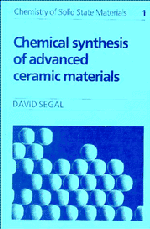Book contents
- Frontmatter
- Contents
- Preface
- Symbols
- 1 Introduction: the variety of ceramic systems
- 2 Conventional routes to ceramics
- 3 Ceramic fabrication
- 4 Sol–gel processing of colloids
- 5 Sol–gel processing of metal–organic compounds
- 6 Non-aqueous liquid-phase reactions
- 7 Polymer Pyrolysis
- 8 Hydrothermal synthesis of ceramic powders
- 9 Gas-phase reactions
- 10 Miscellaneous synthetic routes to ceramic materials
- Appendix: Determination of particle size
- References
- Index
6 - Non-aqueous liquid-phase reactions
Published online by Cambridge University Press: 04 April 2011
- Frontmatter
- Contents
- Preface
- Symbols
- 1 Introduction: the variety of ceramic systems
- 2 Conventional routes to ceramics
- 3 Ceramic fabrication
- 4 Sol–gel processing of colloids
- 5 Sol–gel processing of metal–organic compounds
- 6 Non-aqueous liquid-phase reactions
- 7 Polymer Pyrolysis
- 8 Hydrothermal synthesis of ceramic powders
- 9 Gas-phase reactions
- 10 Miscellaneous synthetic routes to ceramic materials
- Appendix: Determination of particle size
- References
- Index
Summary
Introduction
The title of this chapter refers to synthesis of advanced ceramic powders by using non-aqueous liquid media, which can be inert or constitute a reactant, for example ammonia, and at the time of writing is particularly associated with silicon nitride. There has been increasing interest during the 1980s in developing low-temperature liquid-phase syntheses, which has resulted in the industrial production of certain powders. Reactions between ammonia and silicon tetrachloride are described in this chapter, together with those involving other chlorosilanes, ammonia and amines. Finally, the preparation of non-oxide powders, as well as Si3N4, with liquid-phase reactions are outlined. Work described here and in chapter 9 highlights the importance of controlling reaction conditions in order to reduce impurity levels such as chlorine in Si3N4. The significance of these levels may not be appreciated when synthesis is viewed strictly from a chemical approach, and without also considering the ceramic applications of, for example, high-temperature structural components.
The reaction between silicon tetrachloride and ammonia in the liquid phase
Persoz (1830) carried out initial studies on the liquid-phase reaction between silicon tetrachloride and ammonia. He considered that the white precipitate obtained on passing NH3(g) through SiCl4 dissolved in benzene at ca. 273 K was silicon tetramide, Si(NH2)4, a conclusion also drawn by Lengfeld (1899) and later by Vigoureux & Hugot (1903).
- Type
- Chapter
- Information
- Chemical Synthesis of Advanced Ceramic Materials , pp. 89 - 98Publisher: Cambridge University PressPrint publication year: 1989

